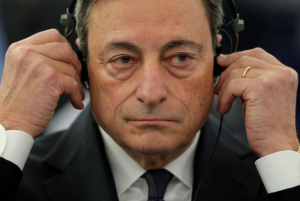No advance guidance on return to normal
 Central Bankers Mario Draghi and Janet Yellen both addressed the Central Bankers Symposium at Jackson Hole Wyoming on Friday. Their speeches were very similar regarding future monetary policy for the ECB and Federal Reserve but the outcome was very different.
Central Bankers Mario Draghi and Janet Yellen both addressed the Central Bankers Symposium at Jackson Hole Wyoming on Friday. Their speeches were very similar regarding future monetary policy for the ECB and Federal Reserve but the outcome was very different.
In not commenting on concerns over Euro strength, Draghi gave traders the green light to continue to buy. He has been clear about there being no opportunity to raise rates yet as the economy is no growing at a constant rate across the entire region. Withdrawal of the additional measures are most likely, in the case of the ECB, to start to happen gradually since eligible German bonds are becoming scarce and the bank is already above its capital limit for buying Italian bonds.
The effect of Janet Yellen not mentioning the start of a reduction in the size of the Fed’s balance sheet or any mention of a further rate hike this year brought about a view that there would be a period of uncertainty where the Fed went into a “wait and see” mode.
The effect of the two speeches was a rise of over 1% for the common currency against the dollar although its rise against Sterling was a little muted.
Brexit talks to restart
 There is likely to be a display of just how far apart the U.K. and EU are in the negotiations as talks restart after the summer.
There is likely to be a display of just how far apart the U.K. and EU are in the negotiations as talks restart after the summer.
In the case of the EU, their position can be distilled into one simple fact; they cannot allow a nation to leach the bloc on terms that provide them with access to the single market that are on a par with continuing members. From the U.K.’s perspective, they require some acknowledgement that they have a special relationship with the region that stems from proximity, shared concerns and a unique trading position.
The unfortunate thing is that those positions have manifested themselves differently. The U.K. Government is grappling with just how much ground they need to give up and the EU negotiating team is becoming increasingly frustrated with what it feels is either reticence to commit or a time-wasting tactic that leads to a “hard Brexit” by default.
The market has passed its judgement on the negotiations, pushing the Euro to levels not seen this decade. The present level of 0.9250 also reflects the market’s view on the path of the U.K. economy over the next eighteen months or so.
Finally, data returns to drive the market
 It is unusual for the U.S. employment report to be released on the first day of the month and it will be on Friday this week. This could easily lead to report that will need radical revision. Traders will be looking at the headline (despite its unreliability) to continue the recent trend of 200k+ new jobs although a downwards revision of any significance could turn sentiment negative very quickly
It is unusual for the U.S. employment report to be released on the first day of the month and it will be on Friday this week. This could easily lead to report that will need radical revision. Traders will be looking at the headline (despite its unreliability) to continue the recent trend of 200k+ new jobs although a downwards revision of any significance could turn sentiment negative very quickly
Eurozone inflation will be released on Thursday. It is likely that it will remain benign possibly falling even closer to 1%. The stronger Euro will start to feed through driving any need for a rate hike further into the future.
Employment data remains stubbornly high across the region. In the established economies of the U.K. and U.S., there is data with sufficient longevity over a range of economic conditions to enable central banks to understand what constitutes full employment. In both countries that is close to 5%. The Eurozone doesn’t yet have access to such data and it is impossible to create a “synthetic” since the individual countries weren’t subject to a single monetary policy.
















